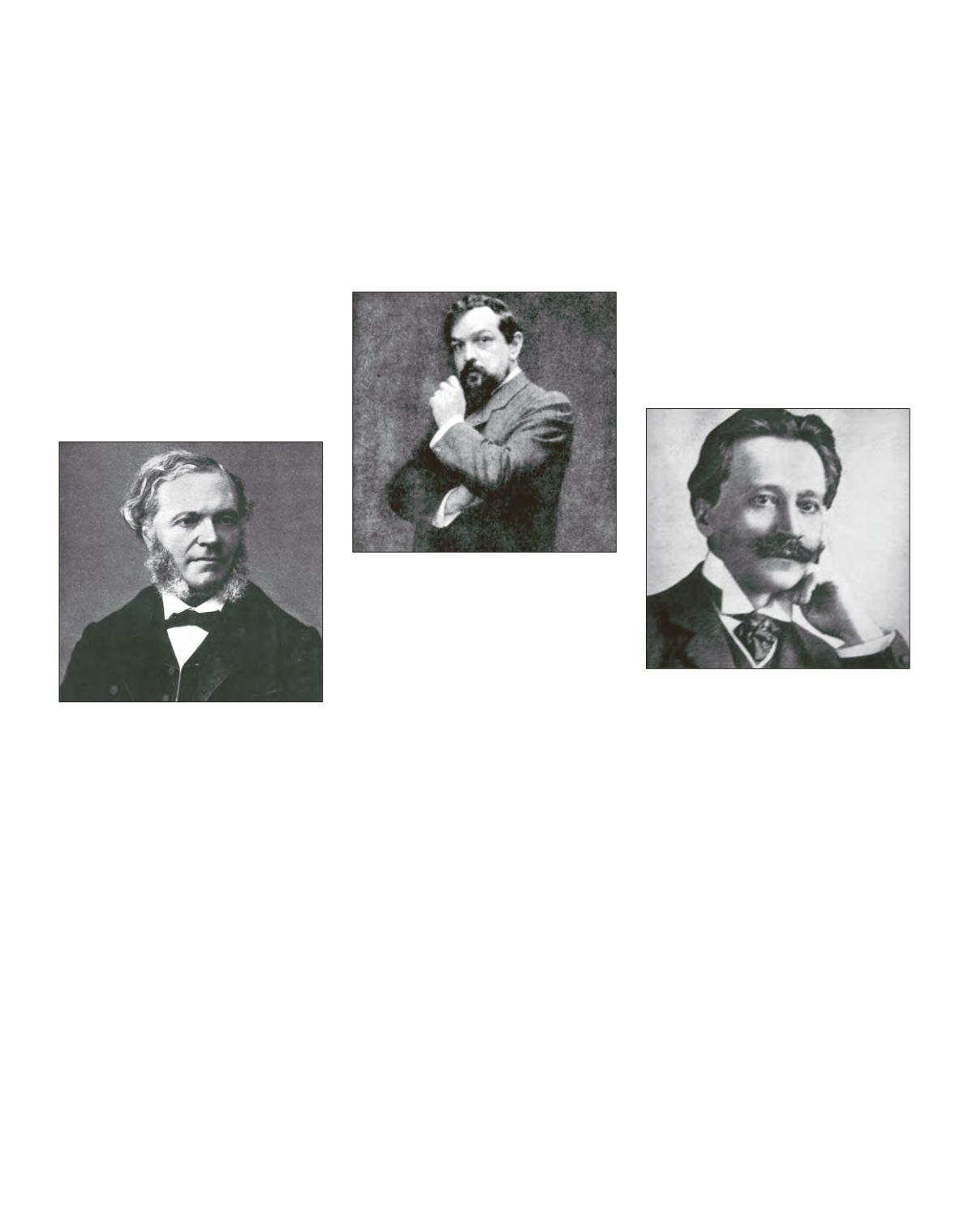

CÉSAR FRANCK (1822–90)
Prélude, choral, et fugue
Franck grew up in the town of Liège, deep in the
French-speaking Walloon region that is now the
southern portion of Belgium. His overzealous
father exploited the prodigious youthful talent,
enrolling César in the Liège Conservatory at
age 8 for studies in
solfège
(sight singing), har-
mony, and piano. After moving to Paris and
becoming a naturalized French citizen, Franck
matriculated in 1837 at the Paris Conservatory,
where he continued to distinguish himself aca-
demically and musically. Franck’s solo piano ca-
reer suffered numerous setbacks, so he withdrew
from the concert stage and focused his energy
almost entirely on the organ. He first served at
the St. Jean–St. François du Marais church and
then presided over the splendid Cavaillé-Coll
organ at the newly completed basilica of Ste.
Clotilde. From 1872 until his death, Franck was
professor of organ at the Paris Conservatory.
The
Prélude, choral, et fugue
(1884) originated in
a period of revived interest in piano composi-
tion. Its premiere took place on January 24, 1885,
at the Société Nationale. This work is subdivided
into three continuous sections, each possessing
a unique musical character. The stylistic influ-
ence of Franz Liszt appears in the chromatic
melodic and harmonic writing, development of
brief musical fragments, and technical virtuosity
required of the performer. A formal indebted-
ness to Johann Sebastian Bach—whose mas-
terful organ creations were central to Franck’s
teaching at the Conservatory—is of equal, if not
greater, consequence. The rhapsodic
Prélude
, an
expressive
Choral
, and the
Fugue
’s interweaving
lines all trace their lineage back to the musical
splendor of the Baroque era in Germany.
CLAUDE DEBUSSY (1862–1918)
Selections from
Préludes
, Books 1 and 2
“My soul is as romantic as a Chopin Ballade!”
wrote the 31-year-old Debussy to his friend
Ernest Chausson. Debussy imagined himself a
direct musical descendant of the Polish pianist
and composer, whose career thrived within
early-19th-century Parisian salons. As a boy,
Debussy studied piano with Mme. Antoinette
Maurté de Fleurville, the mother-in-law of
poet Paul Verlaine, who claimed to have been a
student of Chopin. Her technical anecdotes re-
mained with Debussy throughout his life. More
than once he invoked Maurté de Fleurville’s
name when defending the “Chopinesque” prac-
tice of sparse pedaling. Debussy’s devotion to
Chopin extended to editing his piano works for
a French publisher.
Debussy demonstrated compositional reverence
for Chopin in two books of
Préludes
(1909–10
and 1911–13) and the
Études
(1915), categories
ennobled by the Polish pianist. His
Préludes
were not arranged according to technical or
tonal considerations, as in Chopin’s oeuvre, but
with character contrast in mind. Debussy also
differed from his predecessor by assigning pro-
grammatic titles. Compositional order differed
considerably from the published numbering.
Debussy probably added two or three pieces af-
ter preparing his manuscript for the publisher.
He did not consider these
Préludes
an integral
set to be performed
in toto
. In fact, premieres of
the
Préludes
took place in a random succession.
From Book 1, Debussy played Nos. 1, 2, 10, and
11 in May 1910, and Franz Liebich and Walter
Rummel Nos. 8 and 7 respectively in June and
July; Ricardo Viñes introduced Nos. 5 and 9 and
Liebich Nos. 3 and 4 in January 1911, and finally
Debussy presented Nos. 6 and 12 in March. The
first complete performance occurred in May at
the hands of JaneMortier. FromBook 2, Debussy
played the first three in March 1913, then Viñes
Nos. 4, 7, and 12 in April; Norah Drewett pre-
miered Nos. 5 and 6 days later. Rummel gave a
complete performance of Book 2 in June.
RICARDO CASTRO (1864–1907)
Mazurca melancólica
Mexican pianist and composer Ricardo Castro
grew up in Nazas, Durango, before moving with
his family to Mexico City in 1877, the year his fa-
ther Vicente Castro was elected to the Mexican
Congress. A member of privileged society in the
nation’s capital, young Ricardo also had access
to the finest musical instruction. He entered the
Conservatorio Nacional de Música de México
as a teenager for studies with Juan Salvatierra
and Julio Ituarte (piano) and Melesio Morales
(composition). Castro graduated at age 19 as a
prize-winning pianist, and he almost immedi-
ately became a cultural ambassador of Mexico as
pianist and composer. The government submit-
ted several Castro compositions for the Simón
Bolívar centenary celebrations in Venezuela in
1883. One year later, he represented the Republic
of Mexico at the 1884 World’s Fair—also known
as the World’s Industrial and Cotton Centennial
Exposition—and on a recital tour to Chicago,
New York, and Philadelphia.
As a pianist, Castro presented the Mexican
premieres of several compositional master-
works, among them Schumann’s Piano Quintet,
Tchaikovsky’s Piano Trio in A minor, and Ru-
binstein’s Piano Trio in G minor. Recognizing
the need for more educational and performing
opportunities in Mexico, he co-founded the
Instituto Musical Campa Hernández-Acevedo
(1887), established the Sociedad Anónima de
Conciertos (1892), and created the Sociedad
Filarmónica Mexicana (1895).
Castro joined the composition faculty of the
Conservatorio Nacional in 1900, the same year
his opera
Atzimba
premiered in Mexico City.
The Mexican government awarded Castro a
travel grant to Europe. Arriving in Paris in Jan-
uary 1903, he enjoyed considerable success as
a composer (including the French and Belgian
premieres of his cello concerto) and pianist
(solo recitals and the world premiere of his pi-
ano concerto) over the next three years. During
his European sojourn, Castro studied composi-
tion privately with Eugen d’Albert in Paris, took
lessons with Venezuelan pianist Teresa Carreño,
and attended performances of Wagner’s music
dramas at Bayreuth.
César Franck
Claude Debussy
Ricardo Castro
JULY 23 – JULY 29, 2018 | RAVINIA MAGAZINE
115









